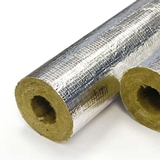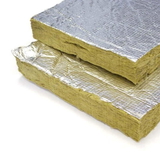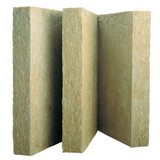- Blogs
- From Stones to Insulation: The Transformation of Rocks into Rockwool
From Stones to Insulation: The Transformation of Rocks into Rockwool

Have you ever wondered how rocks can be turned into insulation? How can something so hard and heavy become soft and light? And why would anyone want to do that in the first place?
In this article, we will explore the amazing process of transforming rocks into rockwool, a type of stone wool insulation that is widely used in the UK and around the world. We will also look at the benefits of rockwool insulation for buildings, people and the environment.
What is Rockwool?
Rockwool is a brand name for a type of stone wool insulation that is made from natural volcanic rock. Stone wool is a generic term for mineral wool that is produced from various types of rock, such as basalt, dolomite, slag and other minerals.
Rockwool insulation is a fibrous material that has a similar appearance and texture to cotton wool. It can be produced in different forms, such as batts, rolls, slabs, granulated or loose fill. Rockwool insulation can be used for various applications, such as external walls, roofs, floors, lofts, facades and fire protection.
How is Rockwool Made from Rocks?
The process of making rockwool insulation from rocks involves several steps, here is an overview of the main stages:
Raw Material Collection and Processing:
The manufacturing process begins with the collection of raw materials, which are sourced from quarries. These materials are then dumped into bins and transported to the processing area.
A hopper with a conveyor system moves the raw materials to the top of the silos, where they are deposited based on their specific composition.
The materials then drop down onto a shaker table, where any larger pieces are crushed to the correct size. A magnet separator removes any metal contaminants before the materials are transported to the furnace.
Melting:
The first step is to crush the rocks into small pieces and feed them into a furnace. The furnace is heated by natural gas and oxygen to reach temperatures above 1500°C.
The rocks are mainly basalt, which is a volcanic rock that contains various minerals, such as iron, magnesium and calcium. The furnace also adds some recycled stone wool and slag, which is a by-product of the steel industry.
The result is a molten lava-like substance that has the consistency of honey.
Spinning:
The next step is to spin the molten rock into thin fibres. This is done by using a spinning machine that has thousands of tiny holes. The molten rock is poured onto the spinning machine and centrifugal force pulls the material through the holes.
As the material exits the holes, it is cooled by air and water and forms long strands of rock fibres. The fibres are then collected on a conveyor belt and sprayed with a binder, which is a resin that helps to hold the fibres together and gives them water-repellent and fire-resistant properties.
Formation and Curing:
The third step is to cure the binder and shape the rock wool material. This is done by passing the material through an oven, where hot air is blown onto it.
The heat causes the binder to harden and the material to form into batts, rolls or slabs, depending on the desired product. The curing process also removes any excess water and dust from the material.
Cutting and Packaging:
The final step is to cut the cured material into different sizes and shapes, according to the specifications of the customers. The material is also marked with labels that indicate the product name, dimensions, performance and installation instructions.
The material is then packed into plastic bags or cardboard boxes and loaded onto trucks for distribution.
Why Use Rockwool Insulation?
Rockwool insulation has many advantages for buildings, people and the environment. Here are some of the main benefits:
- Thermal performance: Rockwool insulation can help maintain a steady indoor temperature by reducing heat loss or gain through the building envelope. This can improve comfort and energy efficiency, as well as lower energy bills and CO2 emissions.
- Fire safety: Rockwool insulation is non-combustible and can withstand temperatures above 1000°C without melting or burning. This can enhance the fire resilience of buildings and protect people and property from fire hazards.
- Acoustic comfort: Rockwool insulation can absorb and reduce sound transmission through walls, floors and ceilings. This can create a quieter and more peaceful indoor environment for occupants.
- Durability: Rockwool insulation is resistant to moisture, mould, pests and chemicals. It does not sag or shrink over time and can last for decades without losing its performance or quality.
- Sustainability: Rockwool insulation is made from natural and abundant resources that are recycled or renewable. It also saves more energy and CO2 than it consumes during its production and use. Moreover, it is fully recyclable at the end of its life cycle.
Note : The data is based on the Annual Reports of ROCKWOOL from 2012 to 2022, The data shows the percentage of rockwool insulation sales in the total insulation market value in the UK. The data for the year 2023 is based on the projections from the ROCKWOOL website, The data is estimated and rounded for simplicity.
What are some other uses of stone wool besides insulation?
Stone wool is a versatile material that has many uses besides insulation. Some of the other uses of stone wool are:
- Filtration: Stone wool can act as a filter for air, water and oil. It can trap dust, bacteria, viruses and other contaminants and improve the quality of the filtered media. Stone wool filters are used in various industries, such as food and beverage, pharmaceutical, automotive and environmental.
- Soundproofing: Stone wool can absorb and reduce sound transmission through walls, floors and ceilings. It can create a quieter and more peaceful indoor environment for occupants. Stone wool soundproofing products are used in various applications, such as cinemas, theatres, studios, offices and schools.
- Hydroponic growth medium: Stone wool can provide a suitable substrate for growing plants without soil. It can retain water and nutrients and provide aeration and drainage for the roots. Stone wool hydroponic products are used in various crops, such as tomatoes, cucumbers, peppers and strawberries.
Frequently Asked Questions
Q: What is Rockwool?
A: Rockwool is a type of insulation material made from rocks. It is also known as stone wool or mineral wool. Rockwool is used as an insulation material in building construction and offers excellent thermal and acoustic insulation properties.
Q: How is Rockwool made?
A: Rockwool is made by heating volcanic rocks at high temperatures and then spinning the heated rocks into fine fibres. These fibres are then compressed into various forms such as rolls, batts, or boards.
Q: Why is Rockwool considered environmentally friendly?
A: Rockwool is considered environmentally friendly because it is made from natural rocks, which are a sustainable resource. Additionally, the production process for rockwool involves low energy consumption and does not produce harmful greenhouse gas emissions.
Q: What are the benefits of using Rockwool as an insulation material?
A: Rockwool offers several benefits as an insulation material. It is fire-resistant, water-resistant, and provides excellent thermal and acoustic insulation. It is also durable, long-lasting, and does not promote the growth of mold or fungi.
Q: Can Rockwool be recycled?
A: Yes, rockwool can be recycled. The Rockwool Group, a leading manufacturer of stone wool products, has established recycling programs to ensure that used rockwool materials are collected and recycled into new insulation products.
Q: Is Rockwool suitable for both residential and commercial buildings?
A: Yes, rockwool is suitable for both residential and commercial buildings. It can be used in various applications, including walls, roofs, floors, and HVAC systems, to provide efficient insulation and improve the energy efficiency of buildings.
Q: Are there any specific guidelines for installing Rockwool insulation?
A: Yes, there are specific guidelines and best practices for installing rockwool insulation. These guidelines ensure proper installation techniques and help achieve optimal insulation performance. It is recommended to consult the manufacturer's instructions or seek professional advice for installation.
Q: Can Rockwool be used for soundproofing purposes?
A: Yes, rockwool is an excellent choice for acoustic insulation. Its dense fibers absorb sound energy, reducing noise transmission between rooms or from external sources. Rockwool can be used in walls, ceilings, and floors to enhance soundproofing capabilities.
Q: Is Rockwool available in different forms and sizes?
A: Yes, rockwool is available in various forms and sizes to suit different construction and insulation requirements. It can be found in the form of rolls, batts, boards, or loose-fill insulation. The availability of different sizes allows for easy customization and installation.
Conclusion
Rockwool insulation is a remarkable product that is made from rocks through a complex and innovative process. It offers multiple benefits for buildings, people and the environment, such as thermal performance, fire safety, acoustic comfort, durability and sustainability.
If you are interested in learning more about rockwool insulation products and solutions for your project, you can contact our team of experts at our website Buy Insulation Online or contact us for any advice and guidance.
We hope you enjoyed this article and found it informative. Thank you for reading!

Samuel Hitch
Managing Director
Buy Insulation Online.
Leave A Reply
Your feedback is greatly appreciated, please comment on our content below. Your email address will not be published. Required fields are marked *












































































































































































































































































































































































